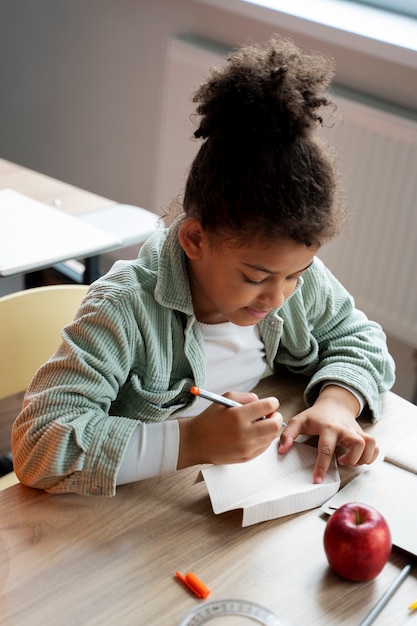Indie Toon
Children’s Day, the dawn of children’s rights
In 1925, the international community held a UN summit in Geneva called the World Conference for the Well-being of Children. The meeting established standards to enforce support and basic rights for children worldwide, leading to the right to education, healthcare, and protection against all forms of exploitation. Today, although not recognized as a...
Data extracted from the Freepik search engine from the last year.

Engaging resources for Children’s Day
-

Children
A child’s smile is contagious. Spread the magic they provide us by applying these delightful children photos to your designs. These high-resolution images are a perfect fit for a young audience or perhaps for educational purposes.
-

Kids playing
Filled with bountiful energy, these photos of kids playing will have us all wishing we were kids once again. Give these highly detailed images a go in your editorial projects. Maybe they will support a preschool brochure or summer camp website with a projection of a healthy lifestyle.
-

School kids
Feel the happiness of these lovely pics. They are filled with smiling school kids that are learning, reading, and sharing stories with their classmates. Download some of them to celebrate Children’s Day with your students or for any other purpose.
-

Family
This collection of family photos will help you create engaging editorial projects. Download some of them and give that professional touch to your creations and designs. Share the happiness of these families with your clients and the people around you.
-

Children’s Day background
Children’s Day backgrounds are a fun and entertaining way to highlight the anticipation for this fun and exciting day. Using vibrant colors, illustrations, and playful cartoons, your banners, event posters, and activities will make an engaging experience.
-

Children’s Day illustration
Get down to their level utilizing Children’s Day illustrations, communicating a positive atmosphere for your creative projects, like decorating a poster as an example. Ready to print, they can be a fantastic opportunity for children to enjoy coloring and drawing.
-

Children’s Day posters
Of course, when it comes to Children’s Day, there is probably an event out there that needs advertising. A Children’s Day poster will do just that! With enchanting colors and playful typography they will be sure to grab parents attention.
-

Children’s Day card
A personalized Children’s Day card will make anybody feel that extra special on a day like this. With so many designs to choose from and customize, they will suit any situation. Children’s Day is about making kids feel special, and this is as special as it gets!
Symbols
Special symbols that represent Children’s Day
Children’s Day Color Palette





Orchid Crayola: comforting and full of love
This pink hue is a delightful addition to your Children’s Day color palette. With close ties to nurturing, love, and constant attention, it will provide your audience with a comforting atmosphere. Orchid Crayola also strongly associates with baby girls and the connection between mother and daughter, a fitting addition to your child-friendly designs. In addition to its purposeful role in the palette, it symbolizes jubilant new beginnings and hope, a very welcome personality to warm up your creative projects. A fun color like this deserves all the attention it can get, so making it a feature of your design will reward you with eye-catching visual communication.
Children’s Day Fonts

The origins of Children’s Day
At the turn of the 20th century, the world had become a very different place. With the industrial age feeding into two World Wars, the resulting difficulties the world faced saw dramatic increases in poverty and starvation worldwide. Desperate situations led to countless acts of exploitation of children in conflict and industry, often involving using them as cheap labor. Where did children fit into all this? Something had to change to give vulnerable children fundamental rights to exist and rebuild a fragile world of their own. Through this timeline, we can discover the origins of Children’s Day and the beginnings of a new world, ultimately a safer environment for children everywhere.
Eglantyne Jebb
The Declaration of the Rights of Children
Eglantyne Jebb was a social reformer living in Geneva. After the dust had settled from the First World War, poverty and starvation were killing thousands of children, and the blockade, set up by the British, was stopping aid from getting to those who needed it. Eglantyne, seeing the desperate suffering of the German and Austrian children, set up the Save the Children Fund, launched in London. The organization quickly raised enough money to dispatch relief workers to affected areas in Europe. Building on the success of Save the Children’s relief effort, she shifted her focus toward children’s rights. In 1923, recognizing the need for a systematic approach, she drafted her first document asserting children's rights. In 1924, the League of Nations recognized her profound work, calling it the Declaration of the Rights of Children, also known as the Declaration of Geneva, and set it in motion.
World War II
Exploitation of children in World War ll and the tragic losses
In World War II, the war effort on all sides exploited the availability of children for their war efforts. At the time, there was no clear definition of a child. Children who lied about their age could join the armed forces or work in a factory without anyone facing legal consequences. With no protection, exploitation and brutal violations were, unfortunately, a common occurrence. The Hitler Youth program was a clear violation of today’s children’s rights, taking mainly young boys out of school, some as young as 10 years old, to start a military training program. They would be taught Nazi ideology and move on to weapons training. A more tragic aspect of this period was the Holocaust, during which countless children, along with their parents, were victims in an attempt to exterminate the Jewish population.
United Nations agreement
Membered states of the general assembly rise to make a stand for the welfare of children everywhere
With the end of World War II, the United Nations came into existence. This meant many international laws had to be reviewed, including The Declaration of the Rights of Children, which was redrafted. Each of the 10 principles outlined in the draft was now enforced by international law. To make a global impact, The Declaration of the Rights of Children would need to be accepted worldwide. Therefore, all member states of the General Assembly unanimously agreed to dedicate one day of the year as Children’s Day, a day to promote, celebrate, and heighten awareness of the welfare of children around the globe.
Choosing the date for Children’s Day
Not all countries adopted the same day for Children’s Day
On November 20th, 1959, the United Nations set in motion The Declaration of the Rights of Children. Each member state would then agree to dedicate a day of the year to highlight its importance. The UN initially proposed that each country choose its own date, suggesting November 20th as a starting point. However, June 1st was adopted by most communist and post-communist countries, and countries like the UK opted for May so kids could have outdoor celebrations.





















